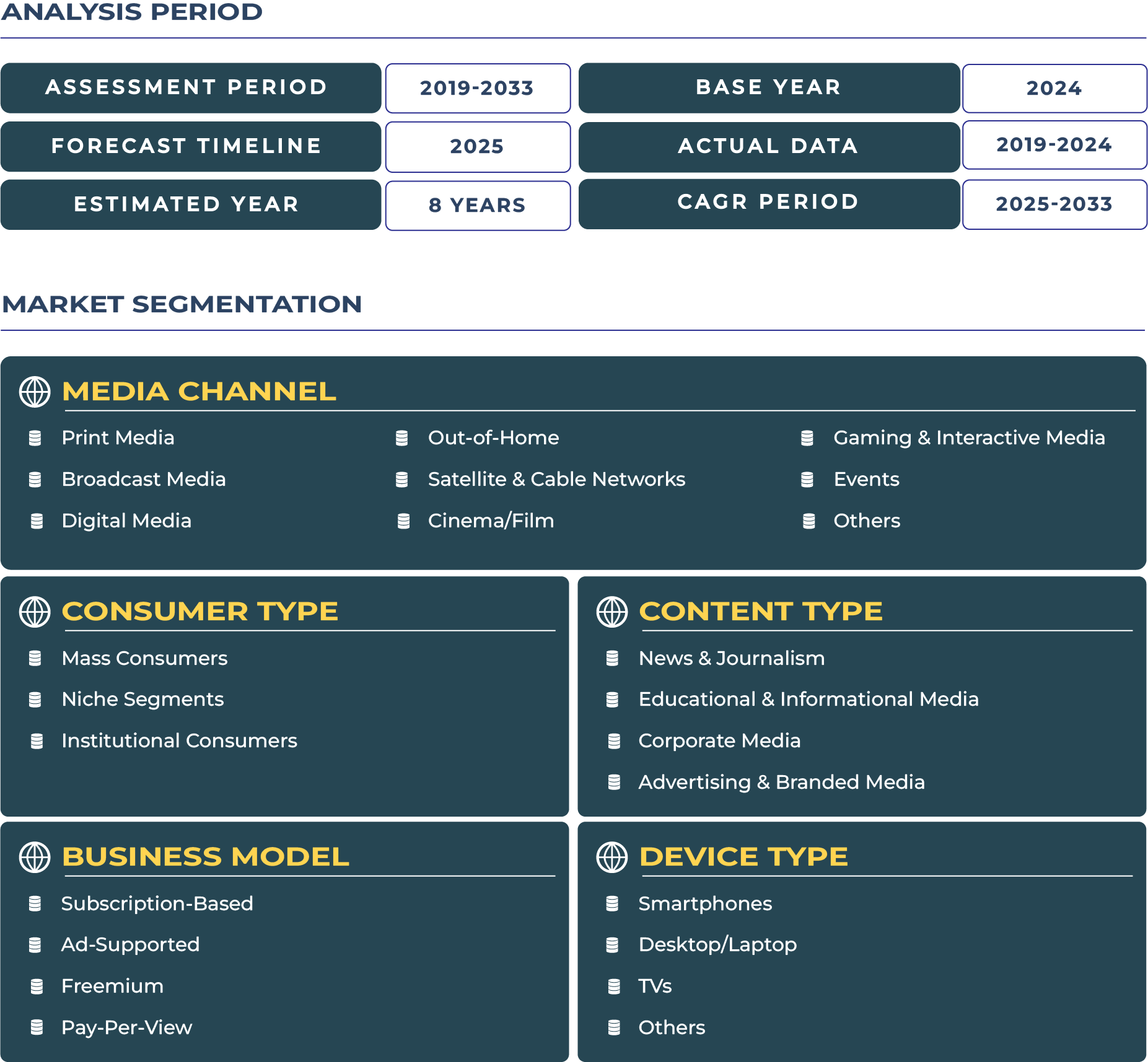Bahrain Media Market Outlook
A Digitally Driven Growth Trajectory
Bahrain media market is undergoing a significant transformation, propelled by digital innovation and shifting consumer behaviors. In 2025, the sector's revenue is projected to reach approximately US$ XXX million, with TV & Video leading at US$ XXX million. Traditional print media, however, faces a downturn, with revenues expected to decline from US$ XXX million in 2024 to US$ XXX million by 2033, reflecting a X.69% CAGR . Conversely, the TV & Video segment is anticipated to grow at a X.88% CAGR, reaching US$ XXX million by 2033, indicating a consumer shift towards on-demand and streaming services
The digital media landscape is expanding rapidly, with digital channels expected to account for XX% of total media revenues by 2033. This growth is underpinned by Bahrain's high internet penetration rate of 99%, facilitated by widespread 5G and fiber broadband coverage. The government's commitment to digital infrastructure and liberal investment policies further bolster this digital shift
Driving Forces: Digital Infrastructure and Youthful Demographics
Several key factors are propelling the growth of Bahrain's media market
- Robust Digital Infrastructure: Bahrain's extensive 5G and fiber-optic networks ensure seamless access to digital content, supporting the proliferation of streaming services and online platforms.
- Youthful, Tech-Savvy Population: A significant portion of Bahrain's population comprises young, digitally native individuals who prefer consuming content on mobile devices and through social media.
- Government Initiatives: Policies promoting digital transformation, such as the Telecommunications, ICT, and Digital Economy Sector Strategy 2022–26, aim to enhance the sector's competitiveness and attract foreign investment.
- Open Market Policies: Bahrain's liberal approach, allowing 100% foreign ownership in the ICT sector and offering tax incentives, encourages international media companies to establish operations in the country.
Market Restraints: Regulatory Challenges and Content Restrictions
Despite the positive outlook, certain challenges may impede market growth
- Regulatory Oversight: The Information Affairs Authority (IAA) exerts significant control over media content, potentially limiting editorial freedom and affecting the diversity of viewpoints.
- Content Censorship: Restrictions on political and religious content can hinder the development of independent media outlets and affect consumer trust.
- Decline of Traditional Media: The ongoing shift towards digital platforms is leading to reduced revenues for traditional media, necessitating adaptation and innovation to remain relevant.
Media Consumption Trends: Embracing Digital Platforms
Bahrainis are increasingly turning to digital platforms for their media consumption needs
- Social Media Dominance: As of early 2024, 97.2% of the population were active social media users, with WhatsApp (74.9%), TikTok (59.4%), and Instagram (58.7%) being the most popular platforms.
- Streaming Services: The preference for on-demand content is evident in the growing user base for streaming platforms, with the TV & Video segment expected to reach 1.3 million users by 2029.
- Decline in Print Readership: The number of readers for print newspapers and magazines is projected to decrease to 0.4 million by 2029, reflecting the shift towards digital news consumption.
Competitive Landscape: Key Players and Strategic Initiatives
Bahrain's media market features a mix of traditional broadcasters and emerging digital platforms
- Bahrain Radio and Television Corporation (BRTC): As the state-owned broadcaster, BRTC operates multiple TV and radio channels, including the popular Channel 44, focusing on Arabic-language content.
- Batelco: The leading telecommunications provider, Batelco offers a range of services, including broadband and mobile telephony, and plays a crucial role in supporting the country's digital infrastructure.
- International Streaming Platforms: Services like Netflix and YouTube are gaining traction, catering to the demand for diverse and on-demand content.
These players are adopting various strategies to enhance their market presence, such as investing in local content production, forming strategic partnerships, and leveraging advanced technologies to improve user experience
Government Regulations: Balancing Control and Innovation
The Bahraini government plays a pivotal role in shaping the media landscape
- Regulatory Framework: The Telecommunications Regulatory Authority (TRA) oversees the sector, ensuring fair competition and consumer protection.
- National Telecommunications Plans: Initiatives like the Sixth National Telecommunication Plan (NTP6) aim to enhance broadband infrastructure and promote digital services.
- Content Oversight: While the government supports digital innovation, it maintains strict control over media content, which can impact the diversity and independence of media outlets.
Author:
Joseph Gomes Y (Head – Media and Entertainment)
*Research Methodology: This report is based on DataCube’s proprietary 3-stage forecasting model, combining primary research, secondary data triangulation, and expert validation. [Learn more]







